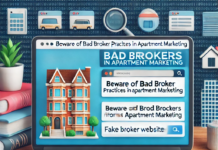Did you know that Google reviews (or reviews in general) increasingly drive local SEO results?
We are all aware that search results drive business. In today’s modern age, if a company doesn’t show up on a Google search, does it even exist? Increasingly, the answer is no.
Furthermore, if a company doesn’t have a 4 or 5 star ranking, will customers even try them? A recent study highlighted by Search Engine Land indicates, most likely not!
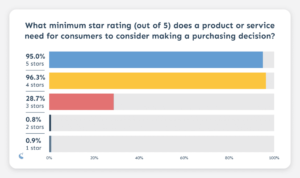
The study, conducted Go Fish Digital, highlights the dramatic drop in customer trust from 4 or 5 stars (roughly 95%) to 3 stars (28.7%)! Driving high quality reviews remains pivotal in appearing in SERPs and demonstrating trust to prospective clients.
So, how does a small company change their rankings? In particular, how does a local business outrank a national competitor and appear in organic results? The answer is local SEO.
In fact, MOZ recently released an annual report on local search rankings, which surveys industry experts on current trends and best practices. The report also clarifies foundational work versus competitive advantages.
“Many of the local search ranking factors are “foundational,” in that they are needed to have any chance at showing in the local results, but continuing to focus on them isn’t going to move the needle (proper GMB categories, for example). On the other hand, many of the factors can be considered “competitive difference-makers” in that continuing to invest in them will push your local rankings further.”
And the results are telling. The following indicates the top signals to appear in the local pack.
- My Business Signals (Proximity, categories, keyword in business title, etc.) 19%
- Link Signals (Inbound anchor text, linking domain authority, linking domain quantity, etc.) 17%
- On-Page Signals (Presence of NAP, keywords in titles, domain authority, etc.) 14%
- Citation Signals (IYP/aggregator NAP consistency, citation volume, etc.) 13%
- Review Signals (Review quantity, review velocity, review diversity, etc.) 13%
Local SEO Requires Fundamentals

As the MOZ local search report indicated, certain fundamental business information remains a requirement. Generally, your company’s NAP (name, address, phone number) must be right. And not only must it be correct, but it needs to be accurate everywhere.
Fundamentals are always important, but especially over the last few years following the Pigeon update that played a major role in local search rankings. As the MOZ report shows, SEO experts place a lot of importance on business signals. The Pigeon update further tightened local search with traditional web search. For example, following the update, local search includes hundreds of ranking signals, along with Knowledge Graph, spelling, synonyms and more that are incorporated into standard search results. Most notable, the update improved the distance between business and searcher.
For companies striving to improve their local rankings, then the priorities remain clear. Keep your business information consistent, leverage the correct categories and include relevant keywords on your site and within your Google My Business listing. These are table stakes in the world of local SEO.
In fact, Search Engine Land provides an overview of the critical local SEO objectives.
- Claim all local name, address and phone number (NAP) citations and listings. Ensure they remain consistent in all listings.
- Claim your Google My Business Page and Bing Places For Business. Fill each with relevant information and local keywords.
- Improve local ratings and reviews.
- Produce content aimed at local long-tail keywords and below-the-fold results.
Reviews Drive Customer Action & Local SEO Results

In a recent report (via BrightLocal) analyzing current customer online interactions, 97% of survey respondents declared they looked online for a local business.
Not only does virtually every potential customer start online, but the survey found that 85% of consumers trust online reviews as much as personal recommendations.
If your company lacks a game plan for generating reviews, then your company is falling behind the competition. Additionally, consumers read an average of seven reviews before trusting a business. This number is up from the previous year and only looks to grow over time.
To make matters more difficult, consumers not only want quality and quantity, but also credibility and relevance. As Birdeye, a review platform, provides analysis of the BrighLocal survey results,
“Credibility and relevance go hand in hand: a whopping 69% of customers agree a review must be written within 2-3 months to be considered relevant. This makes sense. Who knows what’s changed since Marjory wrote about those “Darn good fish tacos” two years ago?”
Plus, not only do potential customers prefer an active review page, but Google prefers velocity of reviews as well. As Google noted frequent updates to pages and results help improve search rankings.
“There are also searches for information that changes often, but isn’t really a hot topic or a recurring event. For example, if you’re researching the [best slr cameras], or you’re in the market for a new car and want [subaru impreza reviews], you probably want the most up to date information.”
Therefore, for any consumer-driven companies, an active review page helps satisfy potential customers, but also Google. And if Google remains happy, then more customers are likely to find your company. And more customers means more reviews!
Google Reviews Help SEO Returns

Reviews, and in particular, Google reviews contribute many factors towards SEO rankings. These combined “review signals” make a difference in local SEO rankings.
- Quantity – more reviews are better and potential customers start trusting business after 7 to 10 reviews.
- Velocity – a steady stream of reviews is better than adding 10 reviews at once, which harms your results.
- Diversity – although focus on Google reviews (and the other major platforms), work towards generating reviews on multiple sites.
- Keywords – if possible, reviews containing product or service keywords help (but don’t stress this or manufacture fake reviews).
- Authoritative – certain customers provide more reviews (in all of their interactions) and contain more credibility and influence.
How do you generate new reviews? Does your digital marketing plan account for these signals? What is your strategy to respond to reviews (in particular negative reviews)?
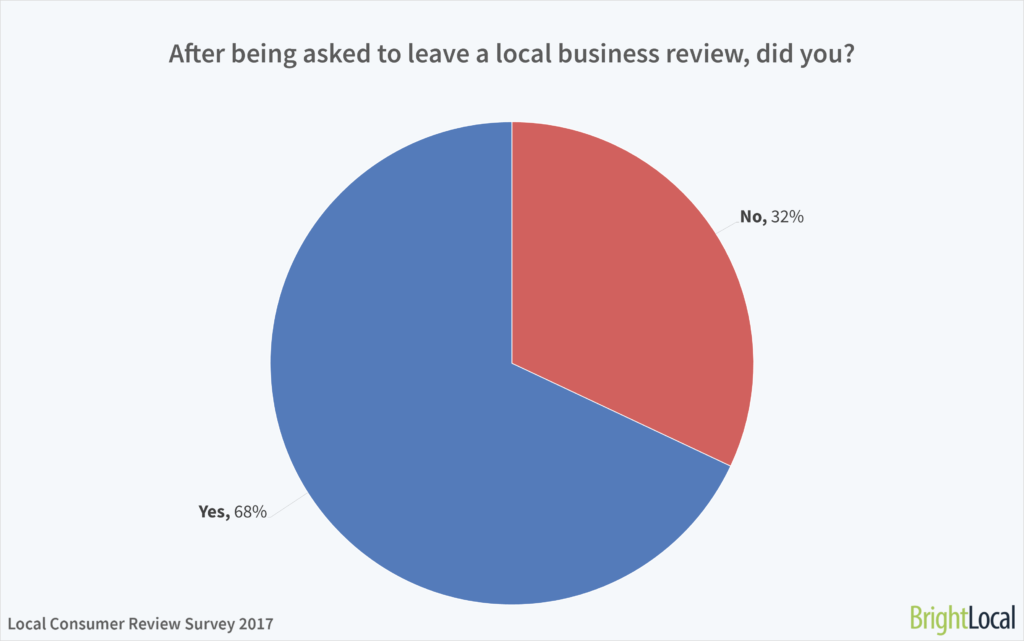
The BrightLocal survey found that 68% of customer did leave reviews when asked!
Generating reviews remains an untapped (and inexpensive) market. Take the time to analyze your customer experience and incorporate the ask into your process. Additionally, include multiple interactions that would trigger a possible positive review from a customer.
“To access this crucial 68% who will leave a review when asked, recognize when a customer is happy with your service, and follow up appropriately to direct them towards your preferred review sites.”
Improved Google Review Rankings Yield Increased Conversion Rates
So, now that we understand that consumers read reviews, what does that mean for your business? Interestingly, a lot!
Uberall conducted a study that aimed at understanding how review ratings and responses translated into business growth. The results are fascinating.
-
Achieving At Least 3.7 Rating Increases Conversions
For example, the study concluded that the most significant jump in conversion rate occurred when ratings jumped from 3.5 stars to 3.7 stars!
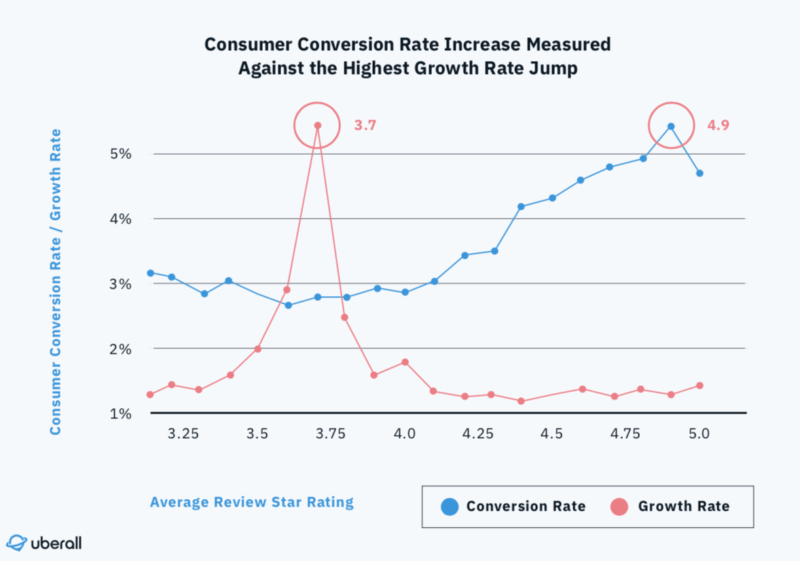
Search Engine Land provided a comprehensive review of the study, which compared data from nearly 64,000 managed listings during the first half of 2018 and 2019. Additionally, the study defines conversions as a combination of phone calls, requests for driving directions and website clicks. This means that based on the study, reviews do not equate to actual sales, but do translate to the mid-funnel actions that lead to sales.
“There are business ratings sweet spots. Locations that improve their Google My Business star ratings from 3.5 to 3.7 can see significant increases in conversions…On the whole, conversion rates peaked when businesses attained 4.9 stars, but it is when businesses improved from 3.5 stars in a given year to 3.7 stars the following year that conversion growth increased by almost 120%, the highest percentage growth jump from any star rating.”
Interestingly, the conversion rate (as defined by the study) shows a reduced growth rate from 4.9 stars to 5.0 stars. Why would this happen? In reality, most customers understand issues happen from time to time, so a perfect star rating does seem off. A company that has been in business for a while will have some complaints. However, the difference between average and great companies is how they respond to complaints.
-
Responding to Reviews Means More Conversions
Additionally, the study also analyzed the impact of responses and found impressive results. The analysis indicates a sweet spot in review responses as well. In fact, responding to about 1/3 of the reviews translated to an 80% increase in conversion rates!
As Search Engine Land concluded:
“By focusing on review star rating and reply rate, brands can massively impact their overall conversion rates. Consumers who are engaging with the brand are also extremely likely to visit a store within 24 hours, so a 25% rise in conversions could also mean a 25% increase in foot traffic every day.”
Ultimately, a steady stream of reviews, likely starting with Google reviews and moving towards other authoritative sites (i.e., Facebook, Yelp) creates positive SEO results. Additionally, focus on responding to a handful of positive, and definitely negative, reviews. Plus, leveraging a few simple plugins help you share those reviews on your site!
Additionally, Google also includes the ability to create shortened URLs to your review form directly from GMB in order to email customers for reviews. As always, Google prohibits incentive programs to generate reviews, but have no concerns about review solicitation from existing customers.
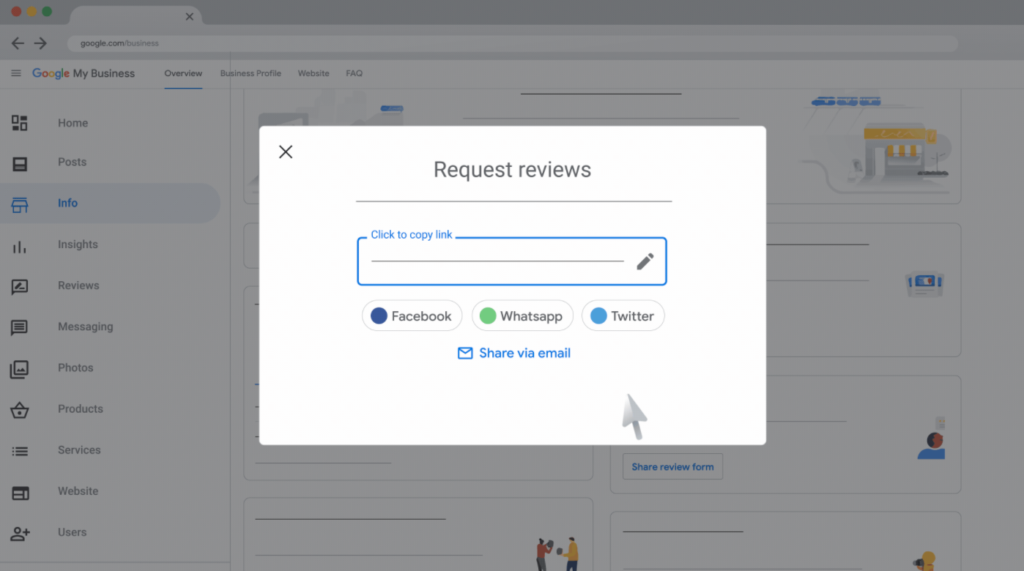
The results speak for themselves, focus on generating reviews and responses translate to more leads, which means more sales growth! Finally, if your business provides a great product, service or experience, customers will provide feedback that will improve your search rankings and sales.



